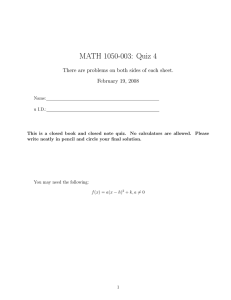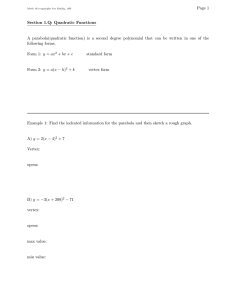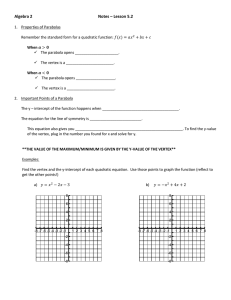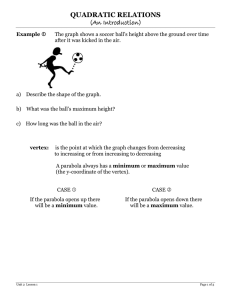Math 1314 notes 3.1 graphing parabolas HCC.doc
advertisement
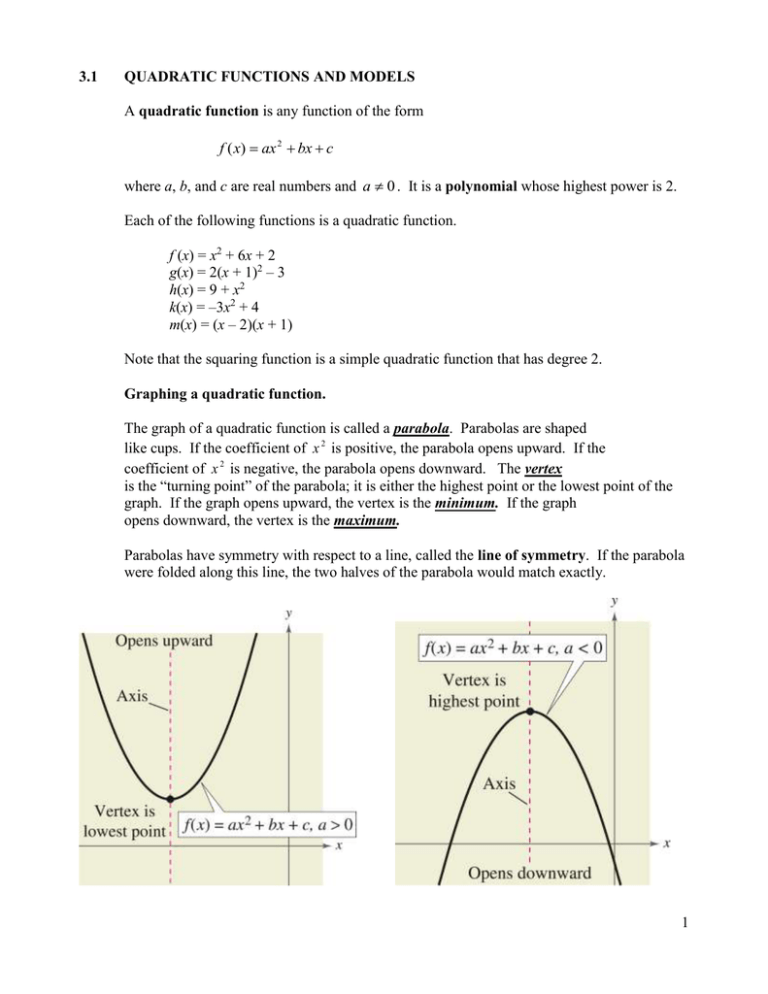
3.1 QUADRATIC FUNCTIONS AND MODELS A quadratic function is any function of the form f ( x) ax 2 bx c where a, b, and c are real numbers and a 0 . It is a polynomial whose highest power is 2. Each of the following functions is a quadratic function. f (x) = x2 + 6x + 2 g(x) = 2(x + 1)2 – 3 h(x) = 9 + x2 k(x) = –3x2 + 4 m(x) = (x – 2)(x + 1) Note that the squaring function is a simple quadratic function that has degree 2. Graphing a quadratic function. The graph of a quadratic function is called a parabola. Parabolas are shaped like cups. If the coefficient of x 2 is positive, the parabola opens upward. If the coefficient of x 2 is negative, the parabola opens downward. The vertex is the “turning point” of the parabola; it is either the highest point or the lowest point of the graph. If the graph opens upward, the vertex is the minimum. If the graph opens downward, the vertex is the maximum. Parabolas have symmetry with respect to a line, called the line of symmetry. If the parabola were folded along this line, the two halves of the parabola would match exactly. 1 You can complete the squares on f ( x) ax 2 bx c to put it in the form g ( x) a x h k , 2 in which case the vertex would be given by the point h, k . The parabola would open upward if a were positive and downward if a were negative. The axis of symmetry would be given by the line x h . A quadratic equation in the form g ( x) ax h k is called Standard Form (also called Vertex Form). 2 To graph a quadratic equation in standard form, follow the steps below: 1. 2. 3. 4. 5. Determine whether the parabola opens upward or downward. Determine the vertex of the parabola (h, k). Find any x-intercepts by replacing f(x) with 0 and solving for x. Find any y-intercepts by replacing x with 0 and solving for y. Plot the intercepts and vertex. Connect these points with a smooth curve that is shaped like a cup. Draw a dashed vertical line for the axis of symmetry. For each sketch, find the vertex, axis of symmetry, x-intercepts, y-intercept, domain, and range. Example 1. a) b) c) d) e) f) Sketch the graph of each: f x 1 2 x 3 f x 2x 2 f x x 2 1 f x x 2 3 2 f x 2 x 2 1 2 f x x 3 1 2 2 Example 1 graphs a) b) c) d) e) f) 3 Graphing quadratics in the form f ( x) ax 2 bx c We complete the square to re-write the equation in vertex form: f (x ) ax 2 bx c ax 2 1 bx c ax 2 a bx c a ax 2 ab xc a b a x 2 x c a b b2 b2 a x2 x 2 c a 4a 4a b b2 a x c 2a 4a 2 2 b b2 c 4a 2a a x ax h k 2 Notice that h, the x-coordinate of the vertex, is given by h b , and k, the y-coordinate of 2a b2 You do not have to memorize the process above. All you 4a b have to remember to find the vertex is that the x-coordinate is given by . The 2a b y-coordinate can be found by evaluating the function at . 2a the vertex, is given by k c 4 The Vertex of a Parabola Whose Equation Is f ( x) ax 2 bx c . If a parabola is defined by the equation f ( x) ax 2 bx c , then the vertex of the parabola b b is given by the point , f . An example will help us understand this better. 2a 2a Example 2 Graph the parabola given by the function f ( x) x 2 4 x 1 . Solution: 5 Example 3 Graph the parabola given by the function f ( x) x 2 2 x 3 . Solution: 6 Example 4 Graph the parabola given by the function f ( x) 3x 2 24 x 1 . Solution: Example 5 Sketch the graph of a parabola f ( x) ax 2 bx c a) if a 0 and b 2 4ac 0 b) if a 0 and b 2 4ac 0 c) if a 0 and b 2 4ac 0 d) if a 0 and b 2 4ac 0 7 Three forms of a quadratic equation: QUADRATIC EQUATIONS Polynomial Form Standard Form Vertex Form Factored Form y ax 2 bx c y ax h k y ax r1 x r2 2 In Standard form, the vertex of the parabola, h, k , can be read from the equation. In Factored form, r1 and r2 are the x-intercepts of the graph of the parabola. The axis of symmetry is found by finding the average of r1 and r2 . Example 6 Write the equation of the quadratic function with vertex 3, 2 and x-intercept 0, 2 . Example 7 Then sketch the graph. Write the equation of the quadratic function whose zeros are 1 and 5 and whose yintercept is 0, 3 . Then graph the parabola. 8 Example 8 Write the equation for each parabola in standard form. a) b) c) d) Maximum and Minimum: Quadratic Functions Consider f ( x) ax 2 bx c . 1. If a is positive, then f has a minimum that occurs at x b . This minimum is found by 2a b evaluating the function f . 2a 2. If a is negative, then f has a maximum that occurs at x b . This maximum is found by 2a b evaluating the function f . 2a 9 Example 9 What is the maximum product of two numbers whose sum is 31? What numbers yield this product? Example 10 Find the coordinates of the vertex of f ( x) x 3 2 and determine if it is a minimum or a maximum of the function. 2 Example 11 The function f ( x) 0.05 x 2 4.2 x 26 models the percentage of coffee drinkers, f(x), who are x years old, who become irritable if they do not have coffee at their regular time. Below is the graph of the function. The vertex reveals that 66.2% of 42-year-old coffee drinkers become irritable. This is the maximum percentage for any age, x, in the function’s domain. 60 50 2 f(x)= -.05x +4.2x-26 40 Vertex: (42, 62.2) 30 20 10 -100 -80 -60 -40 -20 20 40 60 80 -10 -20 -30 -40 -50 10


